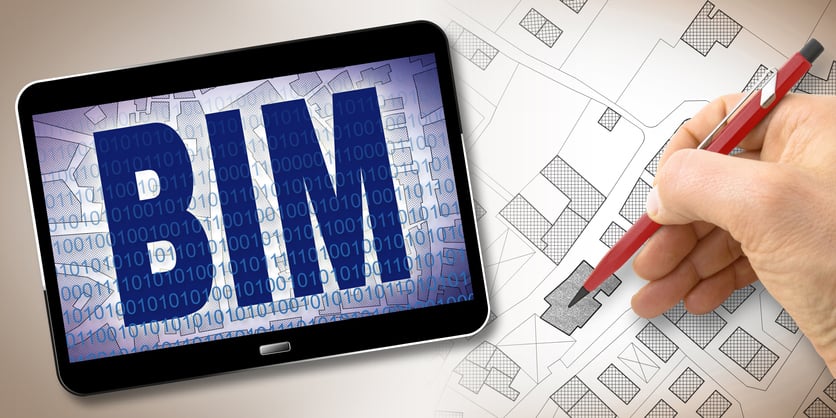
Of all the cutting-edge advances and emerging careers in construction that have entered the industry in recent years, one of the most transformative is something called BIM. If you’re looking to transition to a career in a relatively new and growing field with an annual salary in the range of $50,000 to $95,000, you might want to start your search with those three letters.
BIM is what makes complex building projects like the Shanghai Tower in China and the Oakland International Airport in California possible. An almost $5 billion industry that’s expected to double by 2025, this odd little acronym is revolutionizing how the work of construction is done from top to bottom all over the world.
Don’t believe it? Here’s a few rapid-fire statistics: Studies show that BIM projects see productivity increases in the range of 75 to 240%. Firms that use BIM record project completion times shortened by about 7%. And in case you’re wondering if BIM is a fringe item, more than 40% of construction architects, engineers, and other construction professions have embraced this new technology over the last two decades.
This article will give you a clearer idea of what a BIM specialist is, describe how to become one, and explore the outlook for this still relatively new career path. But before we can take a deeper dive into BIM specialists, we need to answer one seemingly simple question...
What Is BIM?
Building Information Modeling (BIM for short) is a still young, yet highly advanced type of digital technology used to create three dimensional representations of construction projects. The 1960s is when engineers first began imagining how 3D models could be used to aid architects in conceptualizing their designs. These days, computer technology is sufficiently advanced to generate virtual spaces previously only dreamed of in science-fiction novels.

Pen-and-paper sketches, blueprints, computer aided design (CAD) programs—all of these were waypoints on the road to achieving Building Information Modeling tech, but they aren’t what we refer to when we use the term. CAD for example is a highly useful drafting tool, but it’s far more static and less versatile in comparison. BIM is distinct from CAD and its other technological antecedents in that it’s capable of rendering entire structures in their full complexity as immersive, data heavy, and interactive graphical layer cakes responsive to a dynamic range of inputs.
It’s the job of a BIM specialist to make sense of all that.
It’s important to understand, however, that when we use the term BIM, we’re actually talking about a few different things. For starters, there’s the tech itself: all the suites of software and digital tools responsible for generating the 3D models. Of these, Autodesk’s Revit is widely regarded as the industry gold standard in the US, but there are many other examples.
Then, there are the BIM models themselves, the three-dimensional representations of a structure’s spatial layout.

What makes BIM models unique is that they also incorporate an enormous amount of information about the physical materials, functional components, and interrelated systems that make up a built structure. Everything from the chemical composition of a building’s steel girders to the electrical wiring and HVAC systems are included in BIM.
What’s more, each of these design elements can be pulled apart and tweaked within the model. The big picture then automatically updates to remain consistent over time and show how changes to one element affect all the others. This is partially what’s meant when BIM is described as multi-dimensional and “smart.” Smart BIM models can represent not only the geometrical design of a building (3D), but also how much time (4D) it will take for each phase of that design to be completed. Some versions of BIM can also make advanced projections of cost (5D), while others are able to generate data about a building’s energy consumption (6D).
So that’s the technology in a nutshell. But BIM is also a process. The shared digital space provided by BIM has revolutionized how construction gets done, facilitating an unseen level of collaboration between architects, engineers, contractors, and clients through the course of a project’s life cycle. BIM allows for a high degree of input to be included from each of a project’s stakeholders during the design process. This workflow, then, helps guide the contractors through the construction phase. And even upon completion, a BIM model can be handed off to the client, who can then continue using it to monitor vital systems, run analyses, and plot out future alterations to the building.
This multifaceted definition of BIM should hopefully give you some idea of the core competencies involved in this career track. In short, a BIM specialist needs to be as skilled at fostering a collaborative environment with teammates as they are at using the advanced digital tech behind Building Information Modeling.
Which brings us to the meat of the matter.
Job Description: What Does a BIM Specialist Do?
Just like the definition of BIM itself, the BIM specialist career track is best understood when broken down into separate pieces. Depending on the company and its level of BIM adoption, the term “BIM Specialist” may either refer to one specific job or a whole category of jobs.
When used as a specific job title, BIM specialist likely describes the individual at a company who’s responsible for handling any and all things related to Building Information Modeling. When used as an umbrella term, it refers to the variety of branching roles available on the BIM career track. For example, some companies hire a wide range of BIM titles, including BIM modellers, BIM analysts, and BIM managers to form a complete BIM team or department. All of these positions are considered a type of BIM specialist.

BIM is still a very new and growing field, which accounts for some of the variability in the job landscape. A 2017 report by the University of Auckland identified 20 different roles currently on the BIM specialist career track. Other studies, the report notes, have identified as many as 40.
BIM Titles
Here’s a rough breakdown of just a few of those roles (the salary estimates are based on a review of several different job boards and career websites):
BIM Modeller or BIM technician
This is the person who builds the 3D models. An expert in drafting and design, a BIM modeller/technician is highly proficient at using an array of BIM software and digital tools to create complex geometric representations of built structures and environments. It’s their job to collaborate with architects and engineers to incorporate data about various material properties and building systems so as to build each interlocking piece of the 3D model to their exact specifications. A BIM Modeller in the US can expect to make an annual salary of about $50,000 to $70,000.
BIM Analyst
Once the model is built, someone needs to be able to make sense of it. That’s where the BIM analyst comes in. This person seeks out, gathers, organizes, and synthesizes data within the model for the purpose of running simulations and creating archival databases. Experts at statistical analysis, it’s also their job to create presentations and recommend procedures based on their analyses. A BIM analyst can expect to make about $70,000 per year.
BIM Coordinator or Manager
Some companies break these two roles—coordinator and manager—into separate positions. Others do not. Regardless, their duties overlap enough to warrant a single description. A BIM coordinator/manager is responsible for coordinating efforts between BIM team members and other project stakeholders. It’s their job to direct BIM workflow, establish procedures, create BIM training programs, troubleshoot obstacles, identify opportunities for increased efficiencies, and direct the roll out of BIM projects. Another one of their important duties is stay up to date on developments in the BIM technological landscape and strategically introduce upgrades when necessary. A BIM manager can expect to make roughly $60,000 to $95,000 a year.
Then again, a BIM specialist may be expected to fulfill all of these roles at once. Some companies are early in the process of implementing Building Information Modeling, or may have a limited budget, and would therefore most likely hire just one BIM specialist. Other companies are more advanced in their implementation, or may simply be able to devote the resources to hire an entire BIM team composed of separate sub-specialties. Remember, this is still a relatively new field, so job titles and duties are still early in the process of being hammered out from one company to the next.
How Do I Become a BIM Specialist?
Clearly, a BIM specialist needs to be good at a lot of different things. Whatever their specific role, a successful BIM specialist needs to have a firm understanding of architecture and engineering principles. For this reason, a degree in either of those fields is a great launching point for a career in BIM.
At the same time, BIM specialists also need a high degree of competency with the relevant software and digital tech involved in generating BIM models. So a background in computer science is also a viable angle of approach.
The truth, however, is that while some BIM specific degrees and certification programs have sprouted up in recent years, there is no single educational track you’re required to complete before being eligible to work in the field. Many of the people currently working in BIM careers built their own paths, though it’s also true that many were originally architects or engineers (both of which require Master’s degrees) before switching over to BIM. They also spent a lot of time exploring and independently sharpening their drafting and computational skills along the way. Which is to say, that having a background in construction, a higher level of specialized education, and a proficiency in computers doesn’t hurt.

Still, there is indeed no one concrete path to becoming a BIM specialist, which is both an exciting and daunting proposition for someone about to take their first step. It’s clear that those who want to enter this career field have some options to consider, but will benefit greatly by playing to whatever strengths they bring to the table. After all, let’s not forget that in addition to technical skills, another core competency of a BIM specialist is the ability to foster collaboration and high levels of communication between teammates. So whatever your background is, the best thing you can do is stay curious and willing to throw yourself into pursuit of whatever skills you need to succeed in a career as a BIM specialist.
Is BIM a Good Career to Pursue?
With something as new and fluid as BIM, it’s understandable to wonder if it’s a good career to jump into headfirst.
It’s true after all that despite its many benefits, BIM adoption among construction firms has historically been slower than one might expect. Part of this in recent times is due to COVID-19, which has had a dampening effect on construction in general. The reduction in projects in 2020 because of the pandemic meant a decrease in the use of BIM as well. There are other reasons of course for the lag in adoption rates, not the least of which being the construction industry’s well-documented penchant to be slow at adopting any and all kinds of digital technologies.
Still, there’s good reason to believe that the slow tides of BIM adoption are turning. A growing number of countries are beginning to issue mandates that require BIM be used on all large-scale construction projects. The US has yet to follow suit, but some states like Wisconsin and Texas have taken the leap themselves.
At the end of the day, the simple fact is that BIM dramatically improves every aspect of construction. Because of this, the companies that use BIM have a distinct edge on their competition. That edge is sharpened all the more with each addition of a BIM specialist to their teams. Small and medium sized construction companies may be slow on the uptake, but many of the biggest construction firms on the scene are already well aware of this truth: BIM is on the rise, and so too is the demand for those with the skills to use it.
So, is BIM a good career to pursue?
For those with curiosity, boldness, and an eye locked onto the future of construction, the answer is an unequivocal yes.